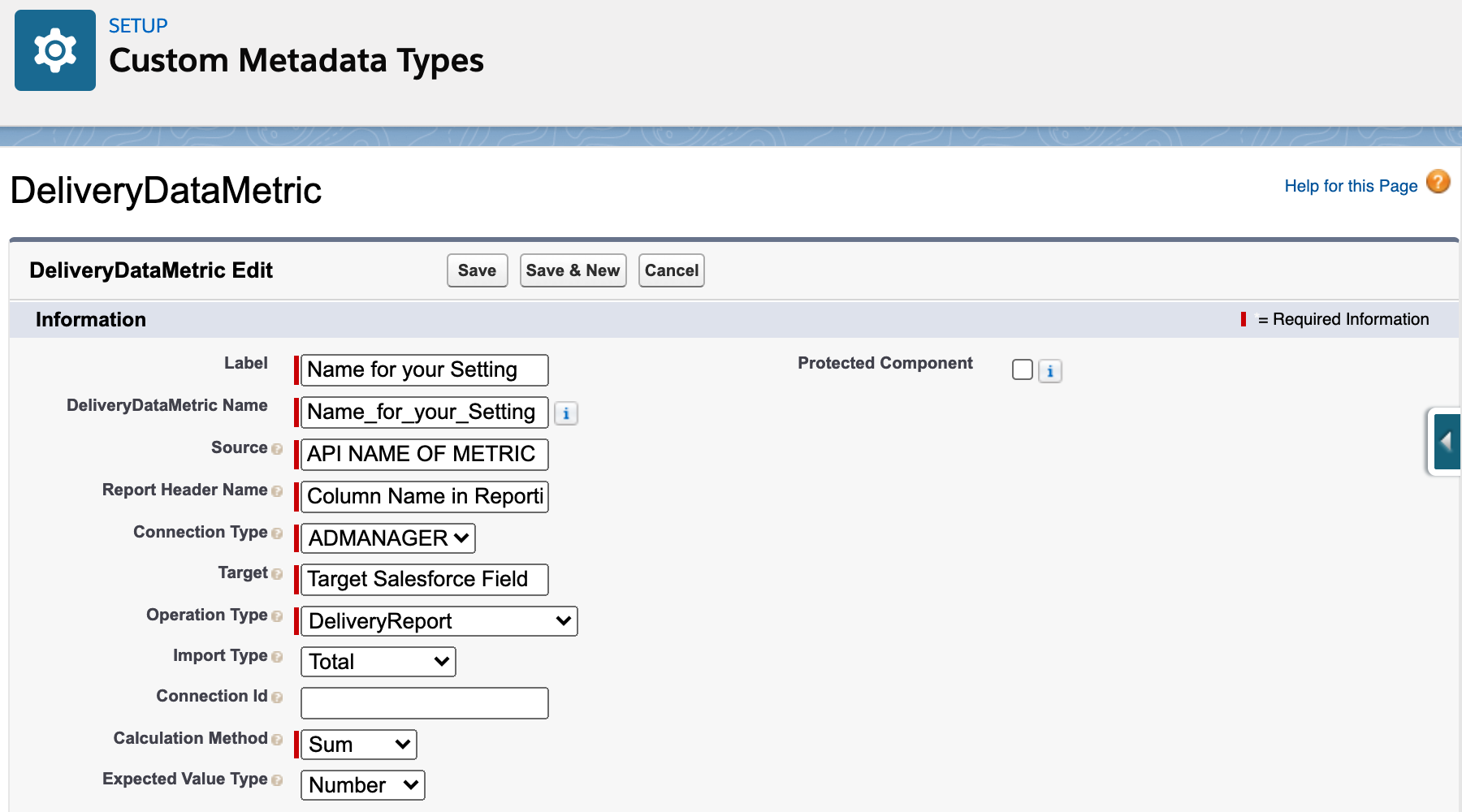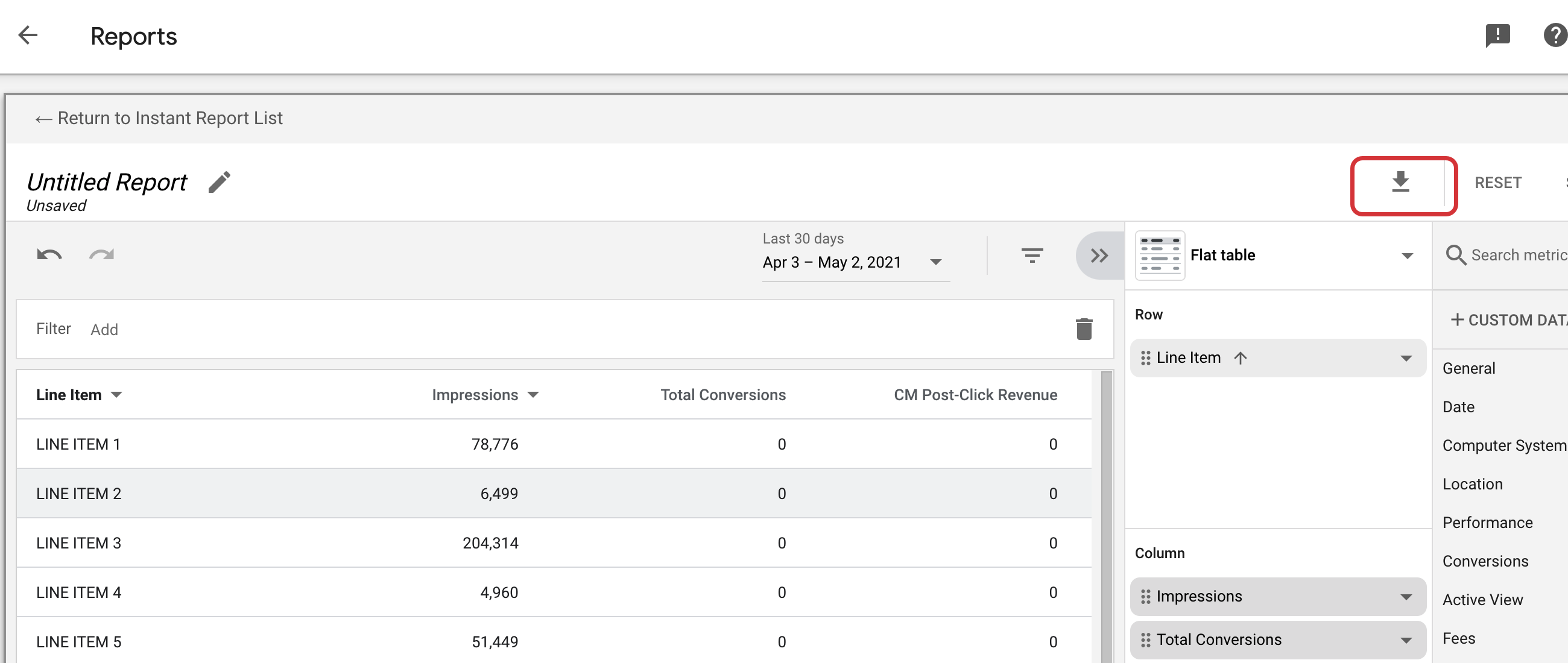Available with Version | 2.139 and up |
|---|---|
Integrations | Google AdManager, Google Display & Video 360, Xandr (Version 2.140 and up) |
License | Connect |
Roles | Product Manager - Product Manager / Sales Support / Marketing ; System Administrator |
Challenge:
The ADvendio delivery report features automatically bring the most important information for Campaign Items back into ADvendio. Key metrics such as Impressions, Clicks and all information needed to be used in our finance module.
But what if additional information are needed, for example:
To judge the performance of Campaign Items, more detailed delivery information such as conversions is needed
Other metrics should be used to base the ADvendio billing process upon, such as Video Views instead of regular Impressions
Solution:
With version 2.139 ADvendio offers a new configuration for integrated external systems such as Adservers. This allows to access additional metrics and numbers from the reporting and map them to ADvendio fields or even custom Salesforce fields of choice.
In order to configure this, the Setup in Salesforce needs to be entered.
There, search for Custom Metadata Types. The following screen should open:
Continue by modifying the setting ‘DeliveryDataMetrics’. In order to do this, click ‘Manage Records’ on the left side.
An overview with all the customer metrics configured in your Salesforce environment will open. Click the new button to create a new setting.
The following information need to be filled:
Label: Give the setting a name, in order to recognize it in the future. The label given is only relevant for managing the settings, it has no influence on the actual delivery import.
DeliverDataMetric Name: A technical identifier for the setting. Will be generated automatically once a label is entered, again no influence on the actual delivery import.
Source: The API name of the metric to be imported from the connected system. For examples of the possible values, see the system specific sections below.
Report Header Name: How the column will be named in the report ADvendio receives. This information is relevant for the right data matching and is system specific. More information below.
Connection Type: For which type of system the metric shall be used. Attention: Currently only Google AdManager, Display & Video 360 and Xandr are supported.
Target: The target field where the information shall be saved. This can be either an ADvendio field or a Custom Salesforce field. Please make sure that the field type is fitting for the desired metric (e.g. a percentage field for a conversion rate in % ). The API name of the field is required, and for ADvendio fields, this includes the prefix: ADvendio__FIELDNAME__c)
Operation Type: Which general import process should be used. Possible values are Delivery Import (for Campaign Items), Enhanced Delivery Report or Buying Delivery Report (for the buyside integration)
Import Type: Which specific type of import, e.g. for the total delivery data (on Campaign Item level) or for monthly, daily or sitebased breakdown?
Connection ID: Optional If this setting shall be used only for a specific connection in the Salesforce Org, paste the record ID of that connection here.
Calculation Method: In certain cases ADvendio needs to calculate with the values received from the external system. Please select if it is expected to simply add the values (e.g. for number of impressions or the total revenue) or if the average needs to be taken (e.g. for average prices like eCPM or conversion rates)
Expected Value Type: Optional Some systems might require some additional transformation of the numbers, so it can be entered, what kind of values is to be expected. E.g. the Google AdManager Reporting API delivers all currencies as cent values (so 10.05$ is 1005), in order to display them correctly in ADvendio, we have to further transform them to the desired outcome. More details in the system specific sections below.
Importing Rates or Average Prices into ADvendio
If you are planning to import certain rates or pricing information into ADvendio please be cautious. The structure of the ADvendio delivery import can cause mismatches in the values that are imported and saved in ADvendio. Especially when using total reports on Campaign Item object, rounding differences can appear.
This affects for example:
an average CPM, CPC, CPA or similar
viewability rates
click through rates
basically all values which are calculated based on the delivered impressions, revenue, clicks ect.
Our general recommendation in those cases is, to import all relevant values for the calculation and then add a custom formula field which uses the same calculation.
For more information on how to handle this see:
Which import processes and types target which ADvendio objects?
As described above, for the metrics settings an operation type and an import type needs to be specified. This is due to the different kinds of imports we have and the different relevant objects, in order to make sure you can configure the right settings here and do the right mapping.
Operation Type:
The operation type is for the general delivery process to use. Here the following options are available:
DeliveryReport: The basic delivery import processes for Campaign Items, which also provide data for our finance module.
EnhancedDeliveryReport: A specific Enhanced Delivery Report for more detailed information and breakdowns on your data. For example a delivery per Device Type.
BuyingDeliveryReport: The import of delivery data specifically for buying items, which will be used by our buyside support module.
Import Type:
Additionally to the basic processes, ADvendio uses different levels and breakdowns on the delivery data. This for example controls if lifetime data, aggregated for the whole item will be imported or if it will be split by months or days.
Please note that the import type in combination with operation type also steers the target object in which data will be imported. You can decide which field to save the data in, but the target object is decided by the Import Type.
Import Type | Operation Type | What will be imported? | Target Object |
|---|---|---|---|
Total | DeliveryReport | The overall delivery information for a Campaign Item | Campaign Item |
Total | BuyingDeliverReport | The overall delivery information for a Buying Item | Buying Item |
Total | EnhancedDeliveryReport | More detailed delivery information (e.g. per device), but summarized per item. | Enhanced Delivery Data |
TotalSite | DeliveryReport | Delivery per site/medium and item | Delivery Data |
Monthly | DeliveryReport | The delivery information for Campaign Items per month | Revenue Schedule |
Monthly | BuyingDeliverReport | The delivery information for Buying Items per month | Buy Data |
Monthly | EnhancedDeliveryReport | More detailed delivery information (e.g. per device), but summarized per month. | Enhanced Delivery Data |
MonthlySite | DeliveryReport | Delivery per site/medium and month | Delivery Data |
Daily | DeliveryReport | The delivery information for Campaign Items per day | Revenue Schedule Daily |
Daily | BuyingDeliverReport | The delivery information for Buying Items per day | Buy Data |
Daily | EnhancedDeliveryReport | More detailed delivery information (e.g. per device), but summarized per day. | Enhanced Delivery Data |
DailySite | DeliveryReport | Delivery per site/medium and day | Delivery Data |
Currently only a certain combination of Import Types and Operations are used:
External System | Operation Type | Possible Import types |
|---|---|---|
Google AdManager | DeliveryReport | Total, TotalSite, Monthly, MonthlySite, Daily, DailySite |
Google AdManager | EnhancedDeliveryReport | Monthly |
Google Display & Video 360 | BuyingDeliverReport | Total, Monthly, Daily |
Google Display & Video 360 | DeliveryReport | Total, Monthly, Daily |
Xandr | DeliveryReport | Total, Monthly, Daily |
Xandr | EnhancedDeliveryReport | Monthly |
Specific Settings for Google AdManager
Source: To access the right metric, you need to use the api name of the metric from the Google reporting API. The list of relevant values can be found here: https://developers.google.com/ad-manager/api/reference/v202102/ReportService.Column
Report Header Name: For AdManager the Report Header Name will always be the same value as the source, with an additional 'Column.' as prefix.
So for example: AD_SERVER_IMPRESSIONS will be Column.AD_SERVER_IMPRESSIONS
Expected Value Type: For AdManager it’s needed to set this, as currency and percentage values will be delivered in a very specific format, which ADvendio needs to transform. If nothing is set in the configuration ADvendio will use the number logic as default.
Specific Settings for Google Display & Video 360
Source: To access the right metric, you need to use the api name of the metric from the Google reporting API. The list of relevant values can be found here https://developers.google.com/bid-manager/v1.1/filters-metrics#metrics
Report Header Name: For the Report Header Name, there are currently some manual steps needed in order to get the right information.
Go into Display & Video 360 and select the insights tab
Go to reporting and create a new instant report
Add the metrics you need as column and then use the symbol to save a csv file of the report.
Now open the csv and copy how the metrics are named there, to add this information to ADvendio. These steps need to be performed as right now it looks like sometimes the name of metrics as listed in DV360 documentation above, differs a bit from the column title in the report.
Specific Settings for Xandr
Source: To access the right metric, you need to use the api name of the metric from the Google reporting API. The list of relevant values can be found here https://docs.xandr.com/bundle/xandr-api/page/network-analytics.html
Our Reporting features are accessing the network analytics report, so the available metrics are based on this.
Report Header Name: Please use the same technical name, as saved in the source field.
Setup:
In order to use the additional metrics, you will need to follow the sets outlined in the description. There is no additional specific setup needed.
If you are looking to create your own Custom Fields in order to store the data, please make sure access rights to these fields are assigned to the right user profiles and the fields are added to the page layouts of the targeting objects (such as Campaign Item or Revenue Schedule)



